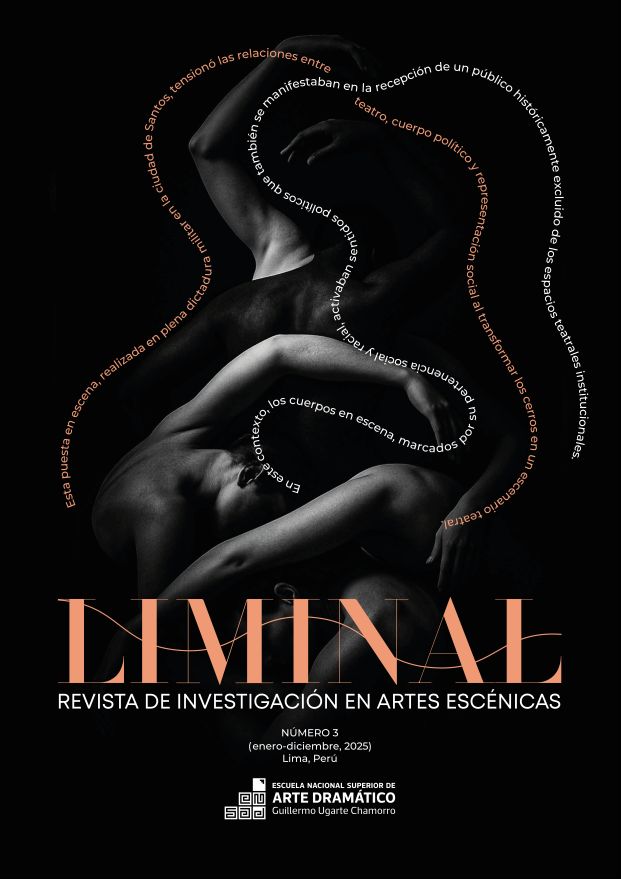Eroticism and violence in the dance of El Descueve as an affective memory of repressive states
DOI:
https://doi.org/10.69746/liminal.a49Keywords:
affective theory , argentine dance, identity, memory, post-dictatorshipAbstract
The article presents an analysis of some elements of the dance works of the independent Argentine group El Descueve (1990-2006) and the media reception, from the perspective of affects proposed by Sara Ahmed (2015).
We consider that what is emotionally significant leaves a firm mark on memory, which is intertwined with emotions and the body, building identity. In Argentina, this identity is linked to the emotional, social and political consequences on the population.
In observing the proposals, we focus on the way the group intends to express the links in human relationships through the use of the naked body, partially or totally, and its gestures, as well as a series of actions that generate different levels of tension between eroticism and violence in the scenes.
The dance works dialogue with their context, which is why we wonder if the selected scenes could be thought of as an unconscious denunciation of the obscenity of the neoliberal policy that was put into practice at the time the works were performed, or if the violent actions observed in the choreographies are a product of the expulsion of emotions repressed during the last dictatorship.
Downloads
References
Ahmed, S. (2015) La política cultural de las emociones. UNAM, Programa Universitario de Estudios de Género.
Bataille, G. (1957) El erotismo.
Bruno, M. (1992a) “La danza joven en escena”. La voz del interior, Córdoba
Bruno, M. (1992b) “Contundente lenguaje de hoy”. La voz del interior. Córdoba
Calzón Flores, N.(comp.), (2009) 25 años del Rojas. Buenos Aires, Libros del Rojas.
Capalbo, A. (1999), “Escenas proteicas”. El menú 69
Carrión, A. M. (2012), “El Descueve: el cuerpo sin límites como clave para la interpretación teatral”. Telón de Fondo
Dubatti, J. (2003) El convivio teatral. Teoría y práctica de Teatro Comparado. Colección Textos Básicos. Buenos Aires: Atuel.
Dubatti, J. (2010), “El teatro argentino en la postdictadura (1983-2005): el canon de la multiplicidad”. RACO, Revistes Catalanes Amb Accés Obert. http://www.raco.cat/index.php/arrabal/article/viewFile/229319/327858
Espinosa, P. (2001), “Urbanos y primitivos”. Funámbulos, Año 4 N°13
Fontana, J. C. (1998), “Animalidad y vigor dramático. Una obra de danza ‘salvaje’ desafía los comportamientos culturales”. La Prensa, 2 de mayo de 1998.
Franko, M. (2019) Danzar el modernismo/Actuar la política. Buenos Aires: Miño y Dávila.
González, M. (2015) “Escenarios urbanos: a propósito de La Organización Negra y su trayectoria centrípeta“. Apuntes de Teatro Nº 140 26-45 Escuela de Teatro - Pontificia Universidad Católica de Chile. https://ri.conicet.gov.ar/bitstream/handle/11336/70359/CONICET_Digital_Nro.c8e3b757-d030-468b-ba3f-8ca9bf9dcfe9_A.pdf?sequence=2&isAllowed=y#:~:text=Melli%2C%20Los%20Macocos%2C%20Batato%20Barea,%2C%20Los%20Twist%2C%20entre%20otros
Groppo, B. (2002), “Las políticas de la memoria”. Revista Sociohistórica, n° 11-12, 187-198.
Hopkins, C. (1994) “La última de El Descueve. Pez fuera del agua”. Página 12, Mayo 1994.
Levine, P. (2018) Trauma y memoria. Cerebro y cuerpo en busca del pasado vivo. Eleftheria
Lorenzano, S. (1998) “Cuerpos que se escriben: por un erotismo político”, https://cdigital.uv.mx/handle/123456789/7383
OMS (2002). Informe mundial sobre la violencia y la salud. Washington, DC: OPS.
Propato, C. (S/F) “Mayra, mujer chancha”. (Sin datos de publicación, material cedido por la intérprete Mayra Bonard)
Ricœur, P. (2012). La memoria, la historia, el olvido. Fondo de Cultura Económica
Schanton, Pablo (1999) “El teatro no fue hecho para aburrir. El Descueve explica por qué Todos contentos es un oasis en el cartel under del verano”. Suplemento joven del diario Clarín, 12 de febrero de 1999.
Santillán, J.J. (2015): “La vuelta del grupo El Descueve”. Suplemento Joven del diario Clarín, Buenos Aires, 30/09/2015. (http://www.clarin.com/extrashow/teatro/El_descueve-Carlos_Casella-Ana_Frenkel-Mayra_Monard-Maria_Ucedo-Gabriela_Barberio_0_1440456355.html)
Soto, Máximo (1993) “El Descueve trajo un soplo de energía con su espectáculo”. Ámbito financiero, Buenos Aires, 2 de agosto de 1993.
Walger, Sylvina (1992), “Sucedió en el barrio”. La maga, Buenos Aires, 5 de agosto de 1992.
Zunino, Pablo (1992), “Dos miradas sobre el amor en La Movida 6”. La Nación Espectáculos, Buenos Aires, 27/5/1992.
Downloads
Published
How to Cite
Issue
Section
License
Copyright (c) 2025 Dulcinea Segura

This work is licensed under a Creative Commons Attribution 4.0 International License.













